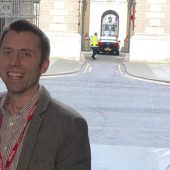
Professor Ian Brown
Former Research Fellow
Professor Ian Brown was Professor of Information Security and Privacy at the OII. His research is focused on surveillance, privacy-enhancing technologies, and Internet regulation.

Today there are multiple technologies that allow us to be tracked, surveilled, profiled and socially sorted as we move through public space. At the same time there is a sense that public space is shifting. The rise of the internet and increasing digital connectivity has led some to argue that technology has redefined what public space could be and where the public realm can now be found. In this project, we set out to explore how robotics might impact upon our experience of public space and bridge the gaps between the ways we communicate in person and online.
The research teams will be examining how to preserve privacy, encourage trust in human-robot communication and the implications of using a robot to stand in for the physical presence of a human. Other areas focus on how to create synchronicity between robotic movement and that of humans in public spaces and measuring how people respond to robots in order to better understand the reception of robots in public spaces.
These themes will be researched using state-of-the-art technologies to measure how people respond to, and interact with other people who are acting through a robot representative. Amongst a range of robotics tools, they will be using an advanced programmable humanoid robot ‘Nao’ that they will take into public spaces around Bristol and Bath to measure human interaction with robots.
This project brings together five teams of researchers from the Universities of Exeter, Bath, Oxford, Cambridge (formerly at Queen Mary University of London) and the Bristol Robotics Laboratory. In addition the researchers are working with a diverse range of creative practitioners from Watershed to add nuance and a disruptive element to the project. A range of artists, designers and game makers all of whom work with technology will be collaborating throughout the project.
This research grant is funded by the Engineering and Physical Sciences Research Council (EPSRC) under its IDEAS Factory Sandpits call on Digital Personhood, grant ref: EP/L00416X/1.

Former Research Fellow
Professor Ian Brown was Professor of Information Security and Privacy at the OII. His research is focused on surveillance, privacy-enhancing technologies, and Internet regulation.

Associate Professor
Joss Wright's research interests lie in information controls, privacy-enhancing technologies, and cyber-enabled crime. His current research focuses on measuring internet censorship, and uncovering the online illegal wildlife trade.

Oxford Internet Institute, University of Oxford